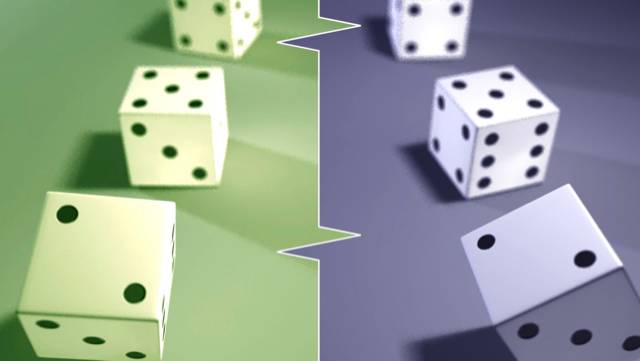Quantum communications and entanglement

Quantum communication uses properties of quantum uncertainty to build secure communication networks. An important role is played by entangled states of light. If two rays of light are entangled, this is manifested by correlations in their uncertainties. If "A" and "B" share an entangled system, then measurements on the subsystems not only result in truly random measurement results, but mutual patterns appear in the random results. The figure on the right illustrates this situation with two fictitious dice, which are supposedly not loaded and thus fall randomly, but always show identical numbers of eyes nonetheless. (Note: A throw corresponds to a measurement. Before each measurement, the cubes must be entangled again.)
Entangled states of light are ideal for distributing a quantum key for quantum cryptography. The property of entanglement provides true randomness for measurements at "A" and "B", at the same time matching of key chains, and additionally the ability to detect potential eavesdropping attempts. The latter becomes possible because eavesdropping (partly) destroys the entanglement and thus leaves its mark on the resulting key.
In 2015, we had the currently most advanced quantum key distribution based on amplitude and phase modulation of light. Our implementation is based heavily on Einstein-Podolsky-Rosen entangled light [1] and is absolutely safe against eavesdropping, even against strategies that may be invented in the future. This certainty is provided by mathematical proof based on quantum theory. From the measurement data at "A" and "B", a truly random and tamper-proof key with a length of over 108 zeros and ones was generated. The special feature of our implementation was its security against all attacks against the channel (including attacks of future technology) plus security against all attacks against the devices at the receiver site [2].
At present, extensive research is being conducted within the scope of quantum communication. A key problem is decoherence, which reduces entanglement during transmission and ultimately makes quantum communication impossible. In 2008 we were able to demonstrate for the first time a two-copy distillation of entanglement [3]. Basic research on the nature of entangled systems also shows surprising results. In our work [4] we were able to show that there are entangled systems that allow Schrödinger's "Steering" effect in one direction only. Whether this result will lead to an application in quantum communication is currently still subject of research. In [5] we measured for the first time the quasi-probability density distribution of the electric field strength of a single-photon focussed state at the telecommunication wavelength of 1550 nm. As predicted by quantum theory, negative(!) values result (Fig.). In [6] we "distilled" a small number of more squeezed states from a large number of only slightly squeezed states. A highly efficient photon counting system was used for this purpose.
[1] T. Eberle, V. Händchen, R. Schnabel, Stable control of 10 dB two-mode squeezed vacuum states of light, Opt. Exp. 21, 11546 (2013).
[2] T. Gehring, V. Händchen, J. Duhme, F. Furrer, T. Franz, C. Pacher, R. F. Werner, R. Schnabel, Implementation of continuous-variable Quantum Key Distribution with composable and one-sided-device-independent security against coherent attacks, Nature Communication 6, 8795 (2015).
[3] B. Hage, A. Samblowski, J. DiGuglielmo, A. Franzen, J. Fiurásek, R. Schnabel, Preparation of distilled and purified continuous variable entangled states, Nature Physics 4, 915 (2008).
[4] V. Händchen, T. Eberle, S. Steinlechner, A. Samblowski, T. Franz, R. F. Werner and R. Schnabel, Observation of one-way Einstein-Podolsky-Rosen steering, Nature Photonics 6, 596 (2012).
[5] C. Baune. J. Fiurasek, R. Schnabel, Negative Wigner function at telecommunication wavelength from homodyne detection, Phys. Rev. A 95, 061802(R) (2017).
[6] S.Grebien, J. Göttsch, B. Hage, J. Fiurášek, R. Schnabel, Multistep Two-Copy Distillation of Squeezed States via Two-Photon Subtraction, Phys. Rev. Lett. 129, 273604 (2022).
